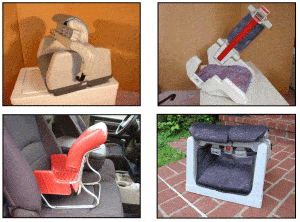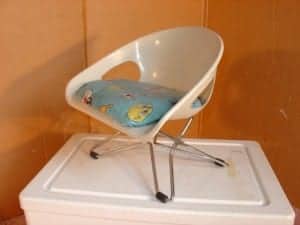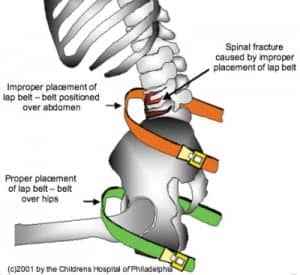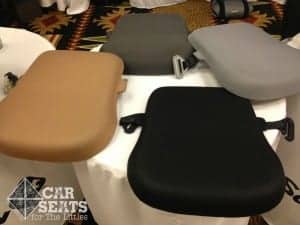Last year, we discussed the science behind why rear facing is safer than forward facing for toddlers and children through four years of age. In this edition of the Science Junkie’s Guide, we will look at booster seats and why they are important for children all the way through puberty. We have also briefly touched on how boosters provide a better fit for children who are nearing the legal age or height to no longer need a booster seat.
The three-point (lap and shoulder) belts with which most vehicles are equipped are designed to do one thing: to restrain the passenger in the event of a crash. The seat belt prevents the passenger from hitting the windshield, other occupants, the seat in front of the passenger, and from experiencing ejection from the vehicle. Why does the person continue to move forward once the car itself has stopped? We all learned Newton’s 1st Law of Motion in grade school science: an object in motion tends to remain in motion (until affected by an external force). The object that ultimately stops the car (whether it be another car, the ground, a tree, or other object), hasn’t actually made contact with the occupants. So, the occupants will continue to move at the speed they were originally traveling, until a counter-force is applied directly to their bodies. The seat belt’s job is to stop that motion and to spread the force over a larger area of the body, creating ‘ride-down’ time as the energy of the crash is safely managed. If the seat belt is fitted correctly those forces will be diverted to the sternum, the rib cage, and the pelvis. Those areas of the body are bone dense, sturdy and protect the soft tissue and vital organs of the body.
In an accident, there are three different crashes that occur. First is the initial vehicle crash where the vehicle hits either another vehicle, object or animal. The second crash is the human crash. This occurs when the person inside the vehicle hits either an object or surface within the vehicle. The third crash occurs internally, when the organs of the body shift and hit either an improperly positioned belt, or other object, with the force of the accident.
If keeping the body in position is what the belts are designed to do, then why do children need booster seats? The seat belts that are installed in vehicles are designed to restrain a fully grown adult and not a pre-pubescent child. The Federal Motor Vehicle Safety Standards is responsible for regulating the testing and all of the assembly standards of vehicles. As occupant protection advances, these standards change. The FMVSS 209 is the portion that is responsible for the assembly and the standards for seat belts. These standards say that the vehicle belt must be able to fit an adult female of 4’11”, 96lbs and with a waist circumference of 23.5inches. They must also fit an adult male who is 6′ 8”, weighs 214lbs and has a 42.5 inch waist. These belts are designed and tested to fit these measurements.1
The average booster law in most states only says that children up to the age of 8 years old need a booster. At 8 years of age, a 50th percentile child weighs 60lbs and is 50.5” tall, far below what a seat belt is designed to fit.2 Meanwhile, an average male child does not reach the height of the adult female before the age of 12.
Height and weight of the individual in question aside, part of the process of puberty includes significant changes to the skeleton in addition to the hormonal changes with which we are all more familiar. The bone mass of a person during the pubescent years increases by 30-40%. Specifically, pelvic bones continue to ossify and are then able to withstand the force that the seatbelt spreads the crash forces onto the body.3
What does the booster do? A properly used booster positions the adult seatbelt in the correct places on a growing body. It moves the belt from its position across the throat, or hovering in front of the child’s torso, over the strong bones in the collar. Without a booster, a child’s lap belt will lie high on the belly, over the vascular and very vulnerable organs. The booster forces the belt low, on the bones of the pelvis, and the femurs, where force can be more effectively absorbed without energy. Having the lap belt positioned correctly also helps to prevent a phenomenon called submarining. Submarining is when a child slides under the lap belt.
You can see in the graphic above that if the lap belt is positioned too high, it can also cut into the spine. The result of this can be spinal fracture, because there is nothing there to take the force of the accident. A booster not only positions the belt low on the hips, but it also acts as a fully mature illiac crest and helps absorb some of the forces of the crash, instead of the child’s body taking all of the force. When the lap belt is too high up on the abdomen, this creates a series of injuries collectively called seat belt syndrome. The medical definition of seat belt syndrome is “Contusion of the anterior abdominal wall caused by lap seat belts, which may produce lumbar spine fractures with horizontal splitting of the vertebral body and posterior arch, trauma to bowel, vessels, spleen and liver.”4
The boosters that are available today have come a long ways from the boosters of yesteryear. Boosters are now rated by the IIHS , or the Insurance Institute of Highway Safety. Boosters are rated on a system of how likely they are to provide a good belt fit. There are four different ratings the IIHS awards boosters:
- BEST BETs are seats that provide good belt fit for typical 4 to 8 year-olds in almost any car, minivan or SUV.
- GOOD BETs provide acceptable belt fit in most cars, minivans or SUVs.
- Not recommended don’t provide good belt fit and should be avoided.
- Check fit applies to booster seats the Institute has tested that have varied results depending on child size and vehicle model. This designation appears on some models in the “Search by brand” section
Booster seats have seen a vast amount of innovation and improvement in the last 30 years. Originally, boosters simply served to ‘boost’ the child, (giving the child a better visual vantage point in the vehicle), and did nothing in the way of improving safety in a car. “Shield boosters” became moderately popular in the 80s and 90s. They utilized only the lap belt. The theory behind the shield seat was that it held the dangerous belt away from the child’s abdomen. In practice, the shield booster did nothing to actually position the belt correctly, and created such a gap between the device and its occupant that the child could easily be ejected from it. The weight and height limitations on these seats were also low.

Shield boosters were used with lap only belts but proved dangerous in design and have been discontinued

Original boosters just lifted the child so they could better see out the window
Manufacturers today are addressing several popular factors that parents and kids run into when it’s time to decide whether or not to
use a booster. Weight and height limits are being increased with almost every booster release, providing a wide array of options for kids of all shapes and sizes. Many more well designed boosters are available at a very low price point, as low as 13 dollars. Manufactures are making boosters more discreet too, so that big kids who might be deterred from using a booster because of what their friends might think, can do so. They’re also making boosters with superheroes, princesses, and a wide variety of other characters and patterns to fit almost any child’s interests and desires. Added ease of use and convenience features like a drawer for paper supplies or small reading lights in the headrest, may serve the child’s needs for comfort in addition to the safety. Travel friendly booster solutions (here and here) mean even families on vacation or who use car-sharing services can make sure their children are correctly restrained 100% of the time. Not only are these boosters fun and easy to use, they give kids the boost they need to fit the adult belt.
Check our complete list of recommended high back boosters and backless boosters. Remember that children who are not yet pubescent will continue to need a booster well beyond 8 years of age, but more typically to 10-12 years of age, and 4’9″-4’11” depending on the vehicle.
Sources Cited:
1. http://www.nhtsa.gov/cars/rules/import/FMVSS/
2. http://www.cdc.gov/growthcharts/
3. http://www.ncbi.nlm.nih.gov/pubmed/10805030
4. http://medical-dictionary.thefreedictionary.com/Seat+Belt+Syndrome
Originally written by Kim Robinson. Edits maintained by CSFTL.





